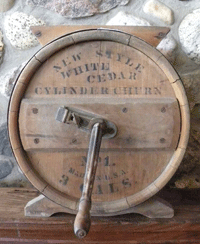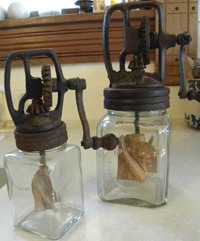|
Butter: How would you like that? Shaken or churned?
| By Debra Tobin
Posted 6/2010
|
 |
While the majority of us choose the convenience of the supermarket to purchase items such as bread and butter, there are those who continue to do things the old-fashioned way. For example, Amish communities are noted for making their own dairy products and other staples needed on a daily basis. There are also some nomadic cultures today that process dairy products, butter in particular, similar to the way their ancestors did during the earlier years of civilization.
Butter is a staple most can’t seem to live without. Everyone loves the sweet creamy taste of this substance, but one must question, “Where and how was this delectable-tasting spread processed before we were able to purchase it in grocery stores?” For those living in the 1800s, the butter churn was the answer, but there were also other communities who resorted to more mundane methods. There is evidence of the use of butter as early as 2000 BC, and the churn itself may have existed as early as the 6th century AD, only in a different form as we know it today.
In ancient times, butter was produced in skin bags made from goatskin or the skin of other animals. Once the animal was skinned, the skin was sewn together, leaving an opening to pour in the cream. The so-called churn was then suspended from tent poles and swung until the cream or milk was broken down into butter. In other instances, the skin bag was attached to a work or pack animal, and as the animal walked, the vessel or “churn” swung back and forth creating creamy butter. Today, some cultures still use a process similar to the aforementioned wherein a bag is filled with milk or cream, tied to a stick and shaken until “butter comes.”
According to records, the first butter churn was patented on February 17, 1891 by A.C. Richardson. It was a large cylinder container made of wood with a plunger-like handle that moved up and down. The movement of the plunger caused the oil parts of the cream or milk to separate. This process forever changed the food industry, paving the way for better and more efficient methods of churning butter.
Historically, Richardson’s churn was the most prominent type of butter churn made. His invention of the plunge churn was also known as the up-and-down churn, churning tub, plunger churn, plumping churn, knocker churn, plump-kirn or plowt-kirn. The plunger or staff used to churn the cream or milk into butter was referred to as the dash, dasher-staff, churn-staff, churning-stick, plunger, plumper or kirn-staff.
Eventually, other materials were used in the production of butter churns. Ceramics (pottery) and galvanized iron was used in the manufacture of many churns throughout history, including the paddle churn. Creamy smooth butter was made in it as the paddles moved through the cream, breaking it up by mixing it with air.
The barrel churn was another very popular type of churn during earlier days. A crank was attached to the barrel which turned a paddle device or turned the whole barrel. Another prominent churn was the rocking chair churn. It was invented by Alfred Clark and consisted of a barrel attached to a rocking chair. When the rocking chair moved, the barrel moved churning the milk or cream into butter.
Some may remember the Dazey butter churn from their childhood days. Butter was made by turning a crank that activated a paddle inside a large glass jar. The Dazey butter churn was once considered a modern tool and was very handy for making small amounts of butter. It is among the most popular churns with collectors today. According to records, in the early 1920s the Dazey Churn & Manufacturing Company claimed their factory produced 2,000 butter churns a day. Today, the Dazey butter churn is being reproduced so buyers should be careful when purchasing to make sure they can distinguish between an antique and a reproduction.
Over the years, many wooden, glass and pottery churns have made their way to antique shows. Collectors have found them to be not only a great conversation piece, but also have great historical value, plus they are ideal for potted plants or dried flowers. Some collectors may have even taken a step back in time and tried their hand at churning butter.
A variety of butter churns can be found at Scott Antique Markets in Ohio and Georgia including wood-, glass- and pottery-style churns. For info, call 740-569-4912 or visit www.scottantiquemarket.com.
|

A three-gallon barrel butter churn purchased which was very popular during the early days.

Two small turn-of-the-century glass Dazey butter churns.
|